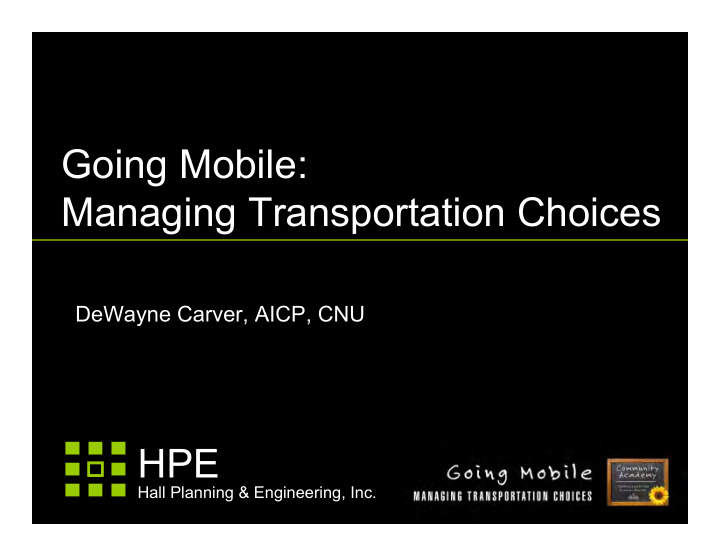



Going Mobile: Managing Transportation Choices DeWayne Carver, AICP, CNU HPE Hall Planning & Engineering, Inc.
Introduction • Bicyclist and bike commuter (LCI) • Member AICP, CNU • Prior work and research on alternative transportation • Senior Project Manager, HPE • Focus on New Urbanist/Walkable Communities transportation design
Content • The Big Picture: Connectivity • Street Level: Streets for People • Transit • Parking
What can transportation planning influence? • Manage Traffic Congestion • Increased viability for other modes of transportation – Walking – Biking – Transit • Health and Fitness • Main Street’s economic health
The Big Picture: Connectivity
Connectivity takes many forms • Street network • Bike lane network • Sidewalk network • Transit network • Paths and trails • Thoroughfares
Intersections/Sq. Mi. • Decatur, Georgia 80 intersections/sq. mi. • LEED ND standard 1 50 intersections/sq. mi. • Desirable conditions 300-400 intersections/sq. mi. • HPE 100 intersections/sq. mi.
Key points • Americans are getting sedentary and obese • Moderate exercise, such as walking, more sustainable than vigorous routines • Bicycling and walking are the most easily adopted and sustained
The Power of Connected Streets Destination Origin How do we get from here to there?
The Power of Connected Streets Destination Origin How do we get from here to there?
The Power of Connected Streets Destination Origin How do we get from here to there?
The Power of Connected Streets Destination Origin 1 Possible Route
The Power of Connected Streets Destination Origin Add a second pair of streets to the network, and…
The Power of Connected Streets Destination Origin 2 Possible Routes
The Power of Connected Streets x= 2 Destination y= 2 Origin Add another street in each direction…
The Power of Connected Streets x= 2 Destination y= 2 Origin More Possible Routes
The Power of Connected Streets x= 2 Destination y= 2 Origin More Possible Routes
The Power of Connected Streets x= 2 Destination y= 2 Origin More Possible Routes
The Power of Connected Streets x= 2 Destination y= 2 Origin More Possible Routes: 6 in all, without doubling back
The Power of Connected Streets (x+y)! (x!)(y!) = # of possible routes The Casey Hawthorne Traffic Routes Equation (only accounts for one direction)
The Power of Connected Streets x= 3 Destination y= 4 Origin Continue enhancing the network: 4 x 3 grid yields 35 routes
The Power of Connected Streets x= 5 Destination y= 4 Origin Continue enhancing th126 routes
The Power of Connected Streets Make 12,870 routes
The Power of Connected Streets Beaufort, SC
Connectivity • Traditional street networks can move as much traffic as larger roads, but with fewer lanes per street • Increased connectivity allows traffic to filter through at lower speeds • Auto LOS is lower, but walkability and sense of place is much higher
Connectivity • North-south streets through downtown Lawrence, KS carry as much or more traffic than arterial Iowa Street • Which street has more walkability – Mass Street downtown or Iowa Street? • Iowa carried 32,000 trips/day (average in 2004 • Downtown streets combined carried 39,000 trips/day
Street Level: Streets for People
What is good “walkability”?
Recreation Walking vs. Destination Walking
Organizing by context Dover, Kohl & Partners ZHA, Inc.
Functional classification Rural Suburban Compact Urban Arterial Collector Local
Context Determines Design • Streets must reflect, not define, land use • Walkable streets are inherently bike-able • What does walkability mean for street design? • Ex. Commerce Ave street trees
Top 10 Walkability Factors – Urban Form • 10. Narrow Streets • 5. On Street Parking • 9. Street Trees • 4. Lower Traffic Speeds • 8. Traffic Volumes • 3. Mixed Land Use • 7. Sidewalks • 2. Buildings Fronting St. • 6. Interconnected • 1. Small Block Size! Streets
Top 3 Walkability Factors – Pedestrians • 3. Vehicle Speed • 2. Vehicle Speed • 1. Vehicle Speed
Pedestrian Fatalities & Speed
Humane Streets
Transit
Transit • Can also be organized by context • Decatur has more options than most similarly-sized towns
On Marta’s Drawing Board
• 8 community bus programs in Broward CO Florida • Found high correlation to population density • Operated in support of regional transit system
• .833 correlation between population density and pass. per hour
• Average cost of $2.18/trip • $1.98 trip for regular service • $17/trip for paratransit • -.58 correlation between income and ridership
Parking
Parking • Estimated value of one adjacent on-street space: $200,000/year in retail sales (Bob Gibbs) • 85% full, is full • Use parking pricing to control turnover • See “High Cost of Free Parking” Donald Shoup
Recommend
More recommend